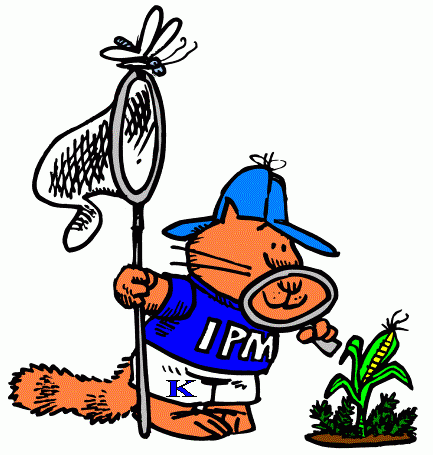IPM Advisory Group
IPM Advisory Group
Stakeholder Identified IPM Priorities
WEEDS
- Morning glory in river bottoms in vegetables
- Winter annuals (henbit, chickweed) in strawberry
- Late season grasses in vegetables
- Waterhemp, Johnsongrass (including Accent resistant and Group 1 resistant), poison hemlock, Marestail, Palmer amaranth, Italian ryegrass, Poa annum, cocklebur, buttercup, ironweed, broomsedge, and thistle control
- Volunteer corn
- Deep-rooted perennial vines (trumpet creeper, milkweeds, morning glory)
- Clover (blooming in orchards and affecting footing in drive rows during wet periods)
- Perennial vines reducing air movement and spray coverage in orchard crops
- Need for overlapping residual applications to extend weed germination management
- Differential stability of residual activity with different herbicides due to environmental factors
- Pre-emergent herbicide management with very early planted soybeans
DISEASES
- Phytophthora in cucurbit and strawberry
- Anthracnose in cucurbits especially in August and September
- Gummy stem blight in squash and zucchini
- Southern rust, gray leaf spot, northern corn leaf blight, Curvularia leaf spot in corn
- Frogeye, Septoria brown spot, Target spot, and Cercospora leaf blight of soybean
- Soybean cyst nematode
- Root knot nematodes in horticultural crops (tomatoes, high tunnels) and soybean
- Lance and lesion nematodes in corn
- White, black and bitter rot of apples vs. pesticide timing issues
- Sclerotina, lettuce drop in high tunnel
- Insect wounds leading to increased disease issues
- Tar spot in corn
- Red crown rot of soybean
- Fungicide resistance
- Stem canker of soybean
- Fusarium head blight (head scab) of small grain cereal crops (wheat, barley, rye).
- Leaf rust, stripe rust, stem rust, and Septoria leaf blotch complex of wheat.
INSECTS
- Earworm management in Bt sweet corn
- New invasive pest awareness for fruit and vegetable crops
- Slugs in soybean
- Stink bugs in soybean, including need for performance ratings
- Sorghum (sugarcane) aphid
- European corn borer in non-Bt corn
- Baldfaced hornet
- Cucumber beetles
- Spotted wing drosophila in small fruit crops
- Japanese beetle
- Spotted lanternfly
- Brown marmorated stink bug
- Emerald ash borer
IPM AND PRECISION AG
- More test strips to get accurate readings of pest movement in Kentucky
- More training in IPM for agents and growers
- Effectiveness of fumigation
- Amount of water actually needed during growing season (drip irrigation)
- Programs addressing use of drone applications
- More Education on fertility management in pastures
- Quantity and quality of lime available in Kentucky (massive disparities)
OTHER PRIORITIES
- Mustard cover crops efficiencies
- General cover crop management (termination, seeding rates vs. stand establishment, vole management, government required seeding rates too high)
- Transplant production (timing of fertilizing and hardening off the plants)
- Using nitrogen to blow off blooms later in the season to limit fruiting
- Pros and cons of plant growth regulators
- Voles in double crop soybeans, long-term no-till fields, and vegetables
- Expanding crop rotation options for row crops
- Racoons in sweet corn
- Increasing deer and bear damage to specialty crops
- Pesticide container sizes don’t always match needs
- Tying IPM practices to ROI
- Organic management guidance
- Complete economic estimate of soybean fungicides use including harvesting and trucking costs.
- Evaluation of new biological products used in addition to existing chemical tools.
BARRIERS TO EFFECTIVE MANAGEMENT
- Diversity of farms require a diversity of solutions
- More factsheets for occasional pests
- More automation for pest monitoring
- Pesticide timing
- Summary factsheets to combat information overload
- Need for more pest alerts
Understanding the barriers to adoption of IPM in Grain and Specialty Crops in Kentucky
Erin Hester, Eleanor Hudd, Nicole Gauthier, Kiersten Wise
The Extension faculty in the Department of Plant Pathology collaborated with Dr. Erin Hester and Eleanor Hudd in the Department of Integrated Strategic Communication in the College of Communication and Information to better understand how stakeholders perceive Integrated Pest Management (IPM) and develop strategic messaging that will lead to behavior change and the adoption of IPM strategies. Dr. Hester is an expert in strategic message design and persuasive communication, and Eleanor is a Ph.D. student in the college of Communication and Information.
Focus groups were held on multiple dates and locations in 2023. Grain crop focus groups consisted of two in-person meetings with 22 County Extension Agents in attendance. County Agents were selected as the primary audience since they interact most frequently with larger grain crop farmers who farm primarily corn, soybean, and wheat. Specialty crop growers participated in three virtual focus group sessions and three in-person session; the 43 participants were full time fruit and vegetable growers or County Agents who farmed part time. Crops represented at specialty crop sessions included, tree fruit, small fruit, large vegetables, pumpkins, chrysanthemums, Christmas trees, and on-farm mixed market growers.
Participants were asked to complete a pre-focus group survey to determine participant demographics, and assess their preferred sources of information for IPM content. During the focus groups, participants were asked open-ended questions and encouraged to discuss their experiences with and understanding of IPM.
Preliminary focus group takeaways were as follows:
- IPM has a branding problem, and many individuals think of IPM as “general farming” or “insect management” and do not understand the broader scope of IPM in terms of other pests, or in terms of specific management strategies.
- To the extent that growers do think of IPM as something distinctly different from the kind of farming they’ve been doing, they often perceive it as risky, as something they need to do on an ongoing basis rather than a one-time process like spraying, and as time intensive.
- Farmers consistently note that hearing about successful strategies that their peers and neighbors have used is compelling. They contrasted this with data from extension, which they tend to view as less applicable to them due to the controlled environments on extension farms and the lack of upward scalability of some of the techniques used in extension experiments. Taken alone, this would suggest that farmers prefer “peer-to-peer” information sources to “top-down” information.
- Participants also indicated that the large number of disease management resources can be overwhelming, and that simplified versions may benefit new and limited resource farmers.
- Risk management in farming influences IPM adoption, and individual farmers have varied approaches to risk management in their operations. Farmers frequently cited fear of immediate economic loss and “peace of mind” (which is likely the inverse of that same fear) as reasoning behind their decisions. The decisions that stem from this mindset are likely the result of a complex cognitive (and sometimes emotionally driven) calculation between economic interests, the time and labor intensiveness of a given task, and the multiple types of information from disparate sources to which farmers have access in a given season.
Our immediate takeaways for strategies to improving messaging surrounding IPM (the low-hanging fruit) include:
- Highlight peer-to-peer “success stories” that describe a farmer’s successful adoption of IPM practices may help make IPM feel more accessible to a wider array of farmers.
- Re-work existing IPM content and create new IPM content that is streamlined and better defines IPM.
- Emphasize that IPM consists of tools that farmers already use and can often save time and money will be key in a successful message design promoting IPM.
Additional focus group sessions are planned for 2024, and potential follow-up surveys have been discussed. Conducting additional groups will help increase number of participants and increase breadth of perspectives.
Focus groups were conducted under University of Kentucky IRB approval, Proposal #84137 "Understanding Barriers to Integrated Pest Management, and funded in part by the University of Kentucky Extension Engagement program”
KY Stakeholder Advisory Group
Producers
Richard Preston, row crops
Joel Wilson, specialty crops
Zeldon Angel, specialty crops
Jed Clark, row crops
Jeremy Hinton, specialty crops
Josh Goodwin, row crops
Jonathan Price, Specialty crops
Randal Roc, row and specialty crops
Susan Miller, specialty crops
Maggie Dungan, specialty crops
UK Specialists
Ric Bessin
Kiersten Wise
Travis Legleiter
Edwin Ritchie
Nicole Gauthier
Rachel Rudolph
Zenaida Viloria
Consultants
Brad Wilks
Bill Brinkley
Shawn Kand
Ronan Cummins
Industry Representatives
Lewis Bradley
Camille Lambert


